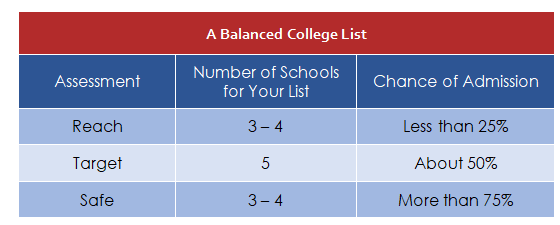 As part three of our blog series, Crafting Your College List, now it’s time to narrow down the list of schools you will apply to, and ensure that your list is balanced in a way that is right for you. The ultimate goal is not only to be accepted, but to succeed and thrive at the college you choose to attend!
As part three of our blog series, Crafting Your College List, now it’s time to narrow down the list of schools you will apply to, and ensure that your list is balanced in a way that is right for you. The ultimate goal is not only to be accepted, but to succeed and thrive at the college you choose to attend!
Creating Your College List
Assess your candidacy. The most important factors in college admission remain the numbers:
- Grades, especially in the core curriculum courses of English, history, foreign language, math, and science;
- Rigor of curriculum, evaluated within the context of what’s offered at your high school;
- Standardized testing, including the ACT or SAT, AP exams, and IB grades, as appropriate. Due to Covid-19, most schools have adopted a test-optional policy for applicants through at least the fall of 2022.
Learn about your high school’s admissions history. Most secondary schools use Naviance or SCOIR, web-based software programs that present the admissions outcomes of students from your school, based on their GPA and test scores. Compare your academic profile with students from your school who have been accepted to colleges in which you are interested.
For example, below is a Naviance scattergram of students who applied to Emory University from a public high school in New York. If your GPA and test scores place you in the top right of the scattergram, near all the green checks of accepted students, you have a strong chance of being accepted if you meet Emory’s other criteria. If your GPA and test scores place you in the lower left below the icons of accepted students, Emory may be a reach for you, unless you have a strong admissions “hook,” such as being a recruited athlete, legacy, under-represented minority, or first-generation student.
The blue circle in the scattergram below represents a student with a 1340 SAT and 4.8 weighted GPA. For this student, Emory would be a reach even though the GPA is on target with accepted students because the SAT score is far below, and Emory seems to place emphasis on the test scores as well, with accepted students clustered around a a 1500 score.
Boost your candidacy through your personal factors. Although colleges place significant emphasis on your grades and test scores in their evaluation of your candidacy, qualitative factors have increased in importance over the last decade. This year, colleges are even more committed to taking a holistic approach to admissions, as described here by Harvard University’s admissions website for first-year applicants:
While academic accomplishment is important, the Admissions Committee considers many other factors—strong personal qualities, special talents or excellences of all kinds, perspectives formed by unusual personal circumstances, and the ability to take advantage of available resources and opportunities.
Colleges are interested in all the ways that you will contribute to campus life outside the classroom. Engage in extracurricular activities that genuinely interest you. These activities can play a positive role in the following aspects of your application:
- Essays and Interviews: you can discuss your involvement in activities in your Personal Essay, supplemental essays, and interviews;
- Recommendations: you can ask for letters of recommendation from people outside the academic courses, such as research mentors, coaches, clergy, and supervisors of employment or internships
Decide on 10-12 colleges to apply to. After you carefully consider your “best-fit” college features, research and visit your colleges, you are ready to narrow down your list. We recommend that your final college list include 10-12 colleges that match your preferences and goals, with a combination of reach, target, and safe colleges.
Balance “Reach” With “Realistic”
Consider overall admissions trends. The numbers of students attending college has been steadily increasing since World War II, and after a slight 6% dip from 2010 to 2020, is projected to regain its 2010 level over the next decade. In addition, more students are applying to college, and each is applying to an increasing number of colleges. As a result, admissions rates have declined and selectivity has increased. It is more important than ever to have a realistic list.
Make sure your college list is balanced. In a typical college list of 12 colleges, here’s our recommendation for a balance of reach, target, and safe schools:
Tailor your list. Each individual’s college list should be suited to the student’s academic and personal needs. If you would like a very challenging academic environment, and have a strong academic profile, you could have more reach schools. If you would like a more manageable course load, or you are trying to manage learning, emotional, or psychological challenges, you may want to increase the number of safe schools.
In part one of our blog series, Crafting Your College List, we discussed how to identify your Best-Fit College Features. Part two, College Visits, provided tips for researching a college and making the most of your visits.
For more guidance, explore our upcoming presentations on our website or set up a complimentary consultation to learn about our admissions consulting services.
Whatever your question, Collegiate Gateway is happy to help!

